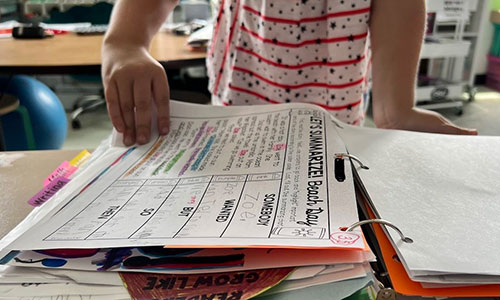
Fences can be really useful. A backyard fence allows the dog freedom of movement without a harness and leash. Fences around a construction site help keep curious people safe from harm.
Sometimes fences get in the way, however. They keep some people out who should be able to get in. They block the view for some who should be able to see. And while people may receive support to work around the barrier a fence presents, others may be left to guess what is on the other side.
A fence is often used as a metaphor to show how students with disabilities are treated in our education system. Many of us know the metaphor from a well-known graphic depicting the difference between equality and equity. In it, three children stand behind a fence at a baseball game. The first panel of the graphic shows equality: Each kid has been given a box to stand on to make it easier for them to see over the fence. But for one of the children, one box isn’t tall enough and they still can’t see. The second panel moves toward equity: Not all the children get a box—because not all the children need one—and the child unable to see over the fence in the first panel now has two boxes, making them just tall enough.
But what if we moved toward full equity, an educational system where all barriers are eliminated and “special” treatment, like boxes to stand on, is no longer needed?
The case for removing the fence
When they keep others out, metaphorical fences tend to create a hierarchy, a system of haves and have nots. Our school systems were built and are funded within this hierarchy. As a result, students with disabilities navigate an education system with a myriad of fences and rely on well-intentioned supports that attempt to help them see over the fences.
As a teacher, I have seen these fences do a lot of harm to our students with disabilities. I also believe there’s a lot we can do to fight inequity in schools. This work can begin with understanding where we’ve been, where we are, and where we can go. It hinges on asking ourselves important questions: Where do we stand in the fight to dismantle inequity? Have we unintentionally walked past a fence we never knew existed? Where is a fence still needed, as long as it gets some much-needed repairs?
Dismantling systemic barriers: The big picture
The Individuals with Disabilities Education Act (IDEA) was passed in 1975, under the name Education for All Handicapped Children Act, and has been through several reauthorizations, including the No Child Left Behind Act in 2004 and Every Student Succeeds Act (ESSA) in 2015. IDEA was originally enacted to ensure all children with disabilities receive a free public school education and related services to meet their unique needs. The act aimed at providing equity for students with disabilities, but it does not necessarily remove the barriers we have within our education system. Instead, it points barriers out and sends those impacted on what is often a more difficult, longer path to what is supposed to be the same educational destination for all children.
In 2010, the Common Core State Standards (CCSS) were created in the hopes of having a shared set of standards at each grade level, giving children all over the country access to a high-quality education regardless of where they live. Whether the CCSS have accomplished that goal is debated by some, but we know this for sure: gaps in achievement remain. In fact, as Katie Pak and Arianna Parsons explain in “Equity gaps for students with disabilities,” this group of students “has chronically underperformed…when compared with their peers without disabilities, on various outcomes—national and state test scores, graduation rates, post high school earnings, and unemployment rates.” Pak and Parsons also note that students of color are overrepresented in special education.
How to remove barriers in your classroom
Legislation in Washington and the adoption of CCSS have been, at times, important in the fight for equity for students with disabilities. Nationwide change can be slow, however, and our kids impacted by barriers can’t wait. There are things you can do in your classroom to provide a more equitable experience for all your students. Here are four specific things to try.
1. Follow Universal Design for Learning guidelines
The Universal Design for Learning (UDL) framework can be applied anywhere learning takes place and focuses on three essential guidelines: engagement, representation, and action and expression. To practice UDL with your lesson planning, work closely with the guidelines. While you may not be able to adopt everything they recommend in a single lesson, small changes can help you move in the right direction. Here are a few examples:
- To engage by optimizing individual choice and autonomy: Let your students pick something to read for an ELA assignment. For example, you could allow your second graders to pick books of their own interest from the library for their assignment aligned to Common Core standard ELA-Literacy.RL.2.7.
- To support representation by clarifying vocabulary and symbols: Read through a word problem with your students, clarifying language related to math, like “add” or “divide,” but also language that helps build context. If the problem describes a Thanksgiving pie recipe, for example, ensure all your students know what Thanksgiving and pie are. And spell out common recipe abbreviations, like “c” for “cup” and “tbsp” for “tablespoon.”
- To support action and expression by guiding appropriate goal setting: Help your students understand what they’re working toward by setting clear goals for them together and by having regular check-ins to measure progress.
2. Protect time for activating background knowledge
Drawing on what students already know is extremely important for all children and is especially important for students with disabilities.
One obstacle students with disabilities face is the changing of classrooms to work on areas of need, which is beneficial and sometimes unavoidable. Ensure this does not happen during teacher-led reading instruction, however. All students need to be present and participate during whole-group reading instruction because this is a prime time for you to directly teach concepts or vocabulary that may not be in a child’s background knowledge. Having to catch students up who miss this creates an unnecessary barrier for those students and leads to them receiving alternate instruction that is often not as effective or authentic.
Ensuring proper scaffolding during this vital instructional time is also important. If a child’s skillset or background knowledge are not within the distance of the fence for this instruction, no amount of boxes to stand on will help that child overcome the barrier.
3. Prioritize representation
All your students need to be able to see themselves in the complex text you are using in your classroom, whether you get it from a district-mandated curriculum, bring in your own, or use a combination. Representation means it will be more likely a student will have the background knowledge that is imperative to understanding. It also means they’ll be more excited to engage with a text because it will mean something to them personally.
Students must be able to understand the texts before them—and they must be given all the tools they need to always access grade-level texts—so they can be successful throughout their academic career. I encourage you to watch Tanji Reed Marshall’s “Curriculum, pedagogy, and power: Details of a just education” to learn more about equity in the ELA classroom.
Representation is important in the math classroom as well. Providing scaffolding for what you are teaching, instead of simplifying it, is key to allowing all students to reach their potential. Math concepts build upon each other, so providing proper support and scaffolding for students is key to enabling them to learn the concepts that will continue to reappear.
4. Eliminate deficit language
One last way to make your classroom a more equitable space is to stop using deficit language. Taking time to ensure you are using the correct terminology when referencing people goes a long way in the classroom and when speaking with students, families, and the community you serve. It can be hard to even notice when we’re using deficit language.
Stay the course
Fences are everywhere in education. It can be overwhelming to knock them down, especially when it feels like they’re multiplying, moving, or changing too quickly. But even the smallest changes can have far-reaching effects if we commit to a cause.
I encourage you to read “Removing systemic barriers in education” by Jana Nicol for more ideas on things you can do. Then start by making small changes to improve equity for the students with disabilities in your classroom. When you’re ready, push out news of your successes—and what you did to accomplish them—to your grade-level teams, school, district, and community. Together we can remove these barriers for our students.







